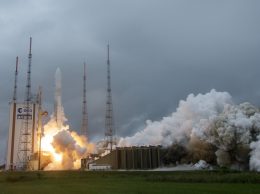SpaceX rocket launches from Vandenberg Air Force Base
By Dana Hull
Elon Musk’s Space Exploration Technologies Corp. returned to the skies Jan. 14 with a flawless delivery of communications satellites into orbit, its first flight since a Sept. 1 fireball destroyed a rocket and its payload on a Florida launch pad.
A Falcon 9 rocket carrying 10 Iridium Communications Inc. satellites rumbled aloft from Vandenberg Air Force Base shortly after 9:54 a.m. amid clear skies and a majestic view of the Pacific Ocean. The rocket’s first stage touched down upright on an unmanned drone ship miles offshore about 8 minutes later, a feat that SpaceX accomplished four times in 2016 and captured on the company’s webcast.
“Mission looks good. Started deploying the 10 Iridium satellites,” said Musk, who watched from the control room with Iridium’s chief executive officer, in a Twitter post. “Rocket is stable on the droneship.”
Musk later confirmed that all of the satellites had deployed, marking completion of the company’s mission.
The triple success — launch, drone-ship landing and mission completion — was a relief and welcome start to the new year for the company. SpaceX hopes to launch 20 to 24 rockets this year, an aggressive pace given that eight missions were completed in 2016. Iridium, one of SpaceX’s largest commercial satellite customers, has signed on for six more launches, all of them scheduled for Vandenberg.
The Jan. 14 success was critical because SpaceX has a contract with the National Aeronautics and Space Administration to send astronauts to the International Space Station and is targeting November for the first demonstration flight and May 2018 for the first test flight with humans aboard.
Musk, who’s also the CEO of Tesla Motors Inc., founded the company 15 years ago with the express goal of sending humans to Mars. The company makes rockets at its headquarters in Hawthorne and has contracts to launch commercial satellites as well as fly missions for NASA and the U.S. military. The closely held company has roughly 5,000 employees.
SpaceX has been awarded NASA contracts valued at $4.2 billion to resupply the Space Station using its unmanned Dragon spacecraft and ultimately to ferry astronauts to the station from the U.S. with a version of the Dragon that’s capable of carrying crews.
The satellites deployed Jan. 14 are part of the Iridium NEXT constellation network, providing new and better communications services such as allowing air-traffic controllers to monitor planes flying over oceans anywhere in the world. Iridium, based in McLean, Virginia, is counting on SpaceX to take 70 new satellites into orbit with seven separate launches over the next 14 to 18 months.
The new satellites would let Iridium offer new services and continue servicing existing clients without interruption. Its existing satellites are 19 years old, which is old by industry standards.
The satellites were placed in a temporary orbit about 390 miles (625 kilometers) above the Earth, where they will be tested in the coming weeks, Iridium said in a statement. The satellites “will then be moved into their 780km operational orbit and begin providing service to Iridium’s customers,” the company said.
• Contact Dana Hull at [email protected].












